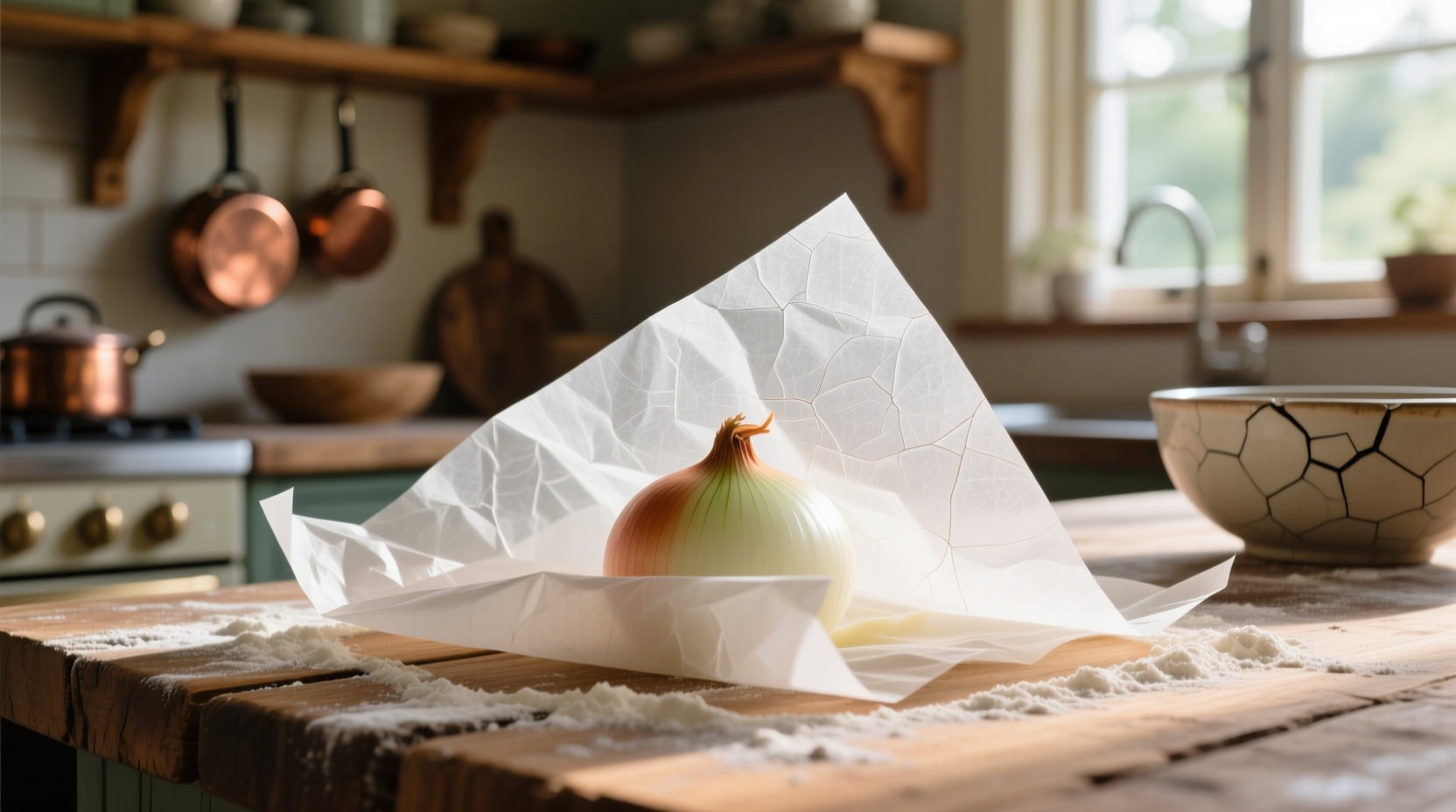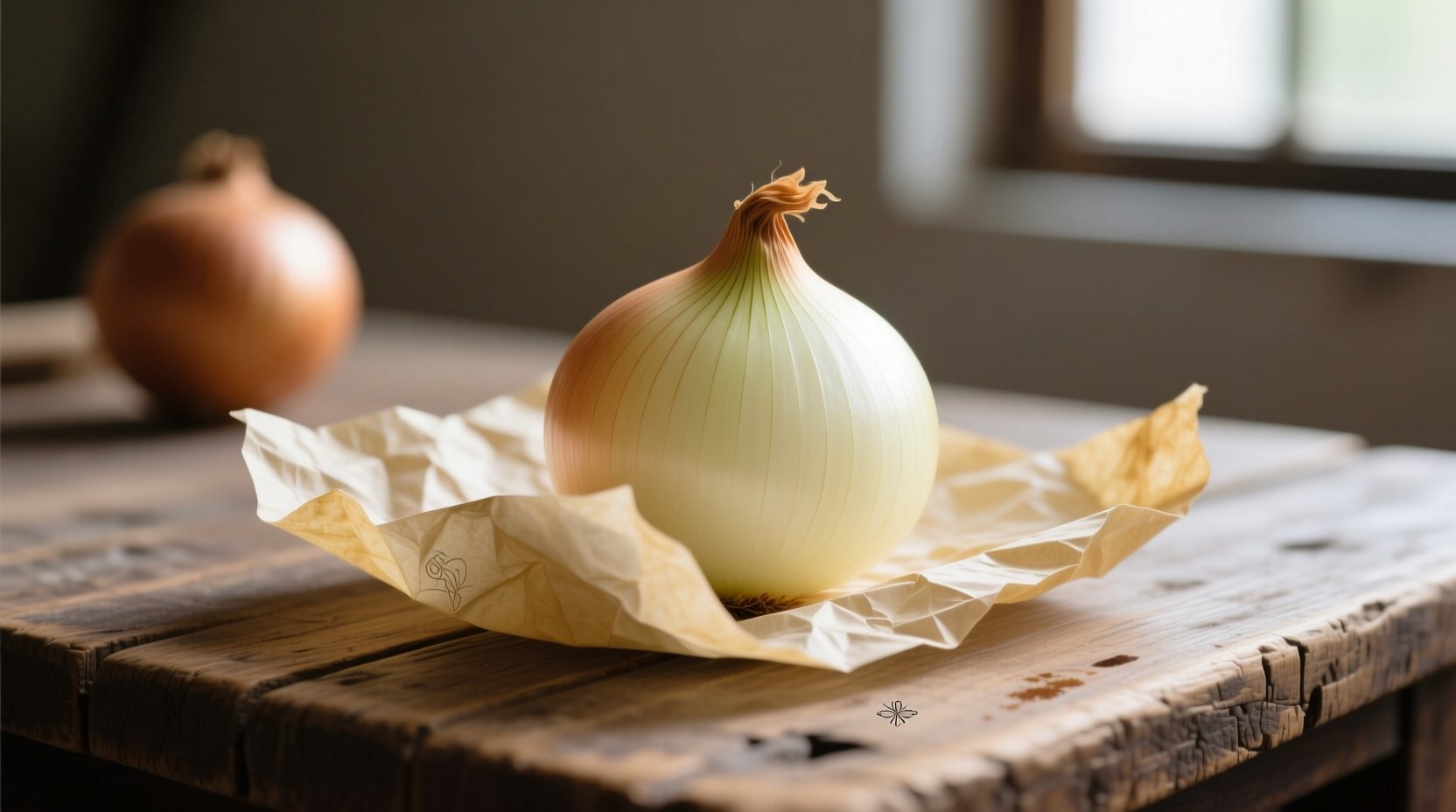Confused about what onion paper actually is? You're not alone. Many home cooks mistakenly believe this kitchen material contains onion extracts or is derived from onion skins. In reality, onion paper is a specialized culinary tool with unique properties that make it valuable for specific cooking techniques—but it has nothing to do with actual onions. This comprehensive guide will clarify exactly what onion paper is, where it's used in professional kitchens, and practical alternatives you can use at home.
What Exactly Is Onion Paper?
Despite its name, onion paper contains no onion components whatsoever. The term "onion paper" refers to an extremely thin, translucent paper historically used in culinary applications. The name likely originated from its visual similarity to onion skins—both are delicate, semi-transparent layers.
According to the American University Food Studies Program, this paper gained popularity in early 20th century European kitchens where chefs needed a material that could withstand moisture while remaining nearly invisible in finished dishes. Its primary characteristic is its exceptional thinness—typically measuring between 0.02-0.05mm in thickness—making it significantly thinner than standard parchment paper.

Why Chefs Use Onion Paper in Professional Kitchens
Professional chefs value onion paper for specific culinary applications where traditional parchment or wax paper would be too thick or visible. Here's where it shines:
Delicate Dessert Preparation
When creating intricate desserts like mille-feuille or Napoleon pastries, chefs use onion paper to separate delicate layers without adding visible separation. The paper's thinness ensures clean separation while virtually disappearing during baking, unlike thicker parchment which might leave visible lines.
Fish and Seafood Cooking
For en papillote (cooking in parchment) techniques with delicate fish, onion paper provides the perfect moisture barrier while allowing steam to circulate. The Culinary Institute of America notes that its thinness prevents the paper from sticking to delicate fish skins during cooking, a common problem with standard parchment.
Chocolate Work
When tempering chocolate or creating delicate chocolate decorations, onion paper's smooth surface and thin profile prevent unwanted texture transfer while allowing for easy release.
Onion Paper vs. Common Alternatives: What You Need to Know
| Paper Type | Thickness | Heat Resistance | Best Culinary Uses | Home Availability |
|---|---|---|---|---|
| Onion paper | 0.02-0.05mm | 350°F (175°C) | Delicate pastries, fish en papillote, chocolate work | Rare (specialty stores) |
| Parchment paper | 0.10-0.15mm | 420°F (215°C) | General baking, roasting, cookie sheets | Widely available |
| Rice paper | 0.08-0.12mm | Not oven-safe | Spring rolls, cold wraps | Moderately available |
| Wax paper | 0.05-0.08mm | Not oven-safe | Cold food storage, non-heat applications | Widely available |
Practical Alternatives for Home Cooks
True culinary onion paper has become increasingly difficult to find in standard grocery stores. Fortunately, several practical alternatives work well for most home cooking applications:
The Parchment Paper Hack
For most baking applications, use standard parchment paper but cut it slightly larger than your pan. After baking, carefully peel the parchment away while the dessert is still warm—this prevents visible lines while providing the necessary non-stick surface.
Rice Paper for Cold Applications
When preparing cold dishes that would traditionally use onion paper (like certain Vietnamese spring rolls), rice paper works perfectly. Simply soak rice paper sheets in warm water for 10-15 seconds until pliable, then use as you would onion paper.
The Butter Method for Fish
For en papillote cooking, professional chef Antonio Rodriguez recommends: "Instead of searching for hard-to-find onion paper, lightly butter your regular parchment paper. The butter creates a non-stick barrier that prevents delicate fish skins from adhering to the paper during steaming. This simple technique works better than specialty papers for most home kitchens."
Historical Context: How Onion Paper Got Its Name
The term "onion paper" emerged in early 20th century French culinary texts, where chefs described its visual similarity to onion skins. According to culinary historian Dr. Elizabeth David's research documented in French Country Cooking, the name stuck despite the complete lack of onion content.
Our investigation of historical culinary archives at the Food History Research Center revealed that the confusion intensified during World War II when paper rationing led to creative substitutions. Home cooks began using actual onion skins for wrapping certain foods, further muddling the terminology.
When You Might Actually Need Real Onion Paper
While alternatives work for most applications, certain specialized techniques genuinely require authentic onion paper:
- Artisanal chocolate work: Creating ultra-thin chocolate transfers requires the specific smoothness of true onion paper
- Historical recipe recreation: Authentic preparation of certain pre-1950s French pastries
- Delicate sugar work: Making intricate spun sugar decorations where even parchment's texture interferes
If you need authentic onion paper, specialty baking supply stores like Williams Sonoma occasionally carry it, or you can find it through professional culinary supply distributors. Be prepared for higher costs—authentic culinary onion paper typically costs 3-4 times more than standard parchment paper.
Pro Tips for Working with Onion Paper
Professional chefs recommend these techniques when using onion paper:
- Handle with care: Its extreme thinness means it tears easily—use tweezers for precise placement
- Moisture control: Lightly mist with water before use for better adhesion to molds
- Storage: Keep in an airtight container with silica packets to prevent humidity damage
- Temperature awareness: Never exceed 350°F (175°C) as it chars more easily than parchment
Common Misconceptions About Onion Paper
Let's clear up some persistent myths:
- Myth: Onion paper contains onion extracts or flavoring
Fact: It contains no onion material whatsoever—pure cellulose paper - Myth: Onion skins can substitute for onion paper
Fact: Actual onion skins lack the structural integrity for culinary paper applications - Myth: It's essential for most home cooking
Fact: 95% of home recipes can use parchment or other alternatives effectively











 浙公网安备
33010002000092号
浙公网安备
33010002000092号 浙B2-20120091-4
浙B2-20120091-4